|
Family:
Rutaceae (the citrus fruit family) Life
> eukaryotes >
Archaeoplastida >
Chloroplastida
>
Charophyta > Streptophytina > Plantae (land plants)
> Tracheophyta (vascular plants) > Euphyllophyta > Lignophyta (woody plants)
> Spermatophyta (seed plants) > Angiospermae (flowering
plants) > Eudicotyledons > Order: Sapindales
About 161 genera and 1815 species (worldwide), with 23 genera
and 298 species native to southern Africa, one genus and species naturalised,
and an additional 20 genera and 33 species cultivated in the region.
Genera native to southern Africa
List is from Victor (2000) with modifications.
Acmadenia Total of 33
species, endemic to Western and Eastern Cape.
|
 |
Adenandra The 18 species are endemic to the Western Cape.
|
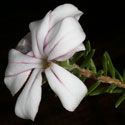
|
Agathosma 140 species, endemic to southern Africa (mainly in the
Western Cape).
|

|
Calodendrum
One species,
Cape Chestnut Calodendrum capense, native to tropical and southern
Africa. See
Flora of Zimbabwe.
|
|
Citropsis About
four species,
native to Africa, with one species, Citropsis daweana, native to
southern Africa. See
Flora of Zimbabwe.
|
|
Clausena About 50 species,
native from Africa through to the Malaysian region, with one species, Clausena
anisata, native to southern Africa. See
Flora of Zimbabwe.
|
|
Coleonema Eight species, endemic to Western Cape and Eastern Cape.
|
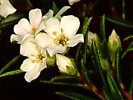
|
Diosma
The 28 species are
endemic to the Western Cape and Eastern Cape.
|
|
Empleurum The
two species
are endemic to the Western Cape and Eastern Cape.
|
|
Euchaetis The 23 species
are endemic to the Western Cape.
|
|
Fagaropsis One species,
Cape Chestnut Calodendrum capense, native to tropical and southern
Africa. See
Flora of Zimbabwe.
|
|
Harrisonia Four
species, native to the Old World, with one species, Harrisonia abyssinica,
native to southern Africa, where it has only been recorded from Mozambique.
Harrisonia was previously placed under the
Simaroubaceae (see
Angiosperm Phylogeny website).
|
|
Macrostylis The 10 species
are endemic to the Western Cape and Eastern Cape.
|
|
Oricia
Eight species, native to Africa, with one species Oricia bachmannii
native to southern Africa.
|
|
Phyllosma
Two species, endemic to southern Africa.
|
|
|
Ptaeroxylon (Sneezewood)
One species:
Ptaeroxylon obliquum (Sneezewood). Formerly placed in the family
Ptaeroxylaceae. See
Flora of Zimbabwe. |
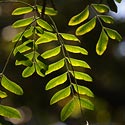 |
Sheilanthera One species, Sheilanthera
pubens, endemic to the Western Cape (Koue Bokkeveld near Ceres).
|
|
Teclea About 22 species,
native to Africa and the Mascarene Islands, with eight species native to southern
Africa.
|
|
Thamnosma About six species,
native to America, Sokotra and Africa, with two species native to southern Africa.
|
|
Toddalia One species, Toddalia
asiatica (see
Flora of Zimbabwe), native from tropical Africa through to Limpopo Province.
|
|
Toddaliopsis The
two species
are native to Africa, with one, Toddaliopsis bremekampii, native to southern Africa.
|
|
Vepris About 15 species,
native mainly to Africa, the Mascarene Islands, and India, with six species
native to southern Africa.
|
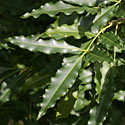 |
Zanthoxylum About 250
species, native from Africa through to the East Indies, with eight
species native to southern Africa.
|
|
Genera naturalised in southern Africa
List from
Plants
of Southern Africa - an Online Checklist (SANBI).
|
Ruta (Rue genus)
Ruta graveolens (Rue, Herb of grace) is
naturalised in southern Africa and in addition Ruta chalepensis (Rue,
as mentioned in the Bible) is cultivated in the region. |
|
Other genera, cultivated in southern Africa
List from Glen (2002). The species name is provided in
genera that have only one species represented in southern Africa.
|
Aegle marmelos (Bael, Bengal quince)
Native to India and Burma. |
|
|
Afraegle paniculata (Nigerian powder-flask fruit)
Native to tropical Africa. |
|
|
Balfourodendron riedelianum (Guatambu, Pau marfim)
Native from Brazil to Argentina. |
|
|
Boronia megastigma (Brown boronia)
Native to westen Australia. |
|
|
Casimiroa edulis (White sapote)
A small tree native to Mexico and Central America. It is
cultivated for the green to yellowish coloured fruit, which are eaten fresh or
used in fruit salads, preserves, sauces, etc. In Mexico, an extract of the seeds is used as a
sedative and seeds are said to reduce blood pressure and have sleep-inducing
effects. |
|
|
Choisya ternata (Mexican orange blossom)
Native to Mexico. |
|
| Citrus
Native from northern India to China and south through Malaysia, the East
Indies and the Philippines. About seven species and more than seven hybrids
are cultivated in southern Africa including familiar fruit such as oranges,
naartjies, grapefruit and lemons. |
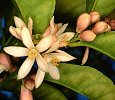
|
|
Correa reflexa
Native to Australia. |
|
|
Eriostemon myoporoides
Native to eastern Australia. |
|
|
Flindersia
Fourteen species, native to Australia, New Guinea, New
Caledonia and the Moluccas. Three species are cultivated in southern Africa,
all from Australia. |
|
|
Fortunella (Kumquat genus)
Two species cultivated: Fortunella japonica (Round
kumquat) and Fortunella margarita (Kumquat). |
|
|
Geijera parviflora (Wilga)
Native to eastern Australia. |
|
|
Melicope ternata (Wharangi)
Native to New Zealand. |
|
|
Micromelum hirsutum
Native from Burma to Vietnam. |
|
|
Murraya
Twelve species, native Indomalesia to the Pacific. Three
species are cultivated in southern Africa including Murraya koenigii
(Curry leaf, Kurripulya leaf), which is used for seasoning curries. |
|
|
Poncirus trifoliata (Trifoliate orange)
Native to Korea and northern China. |
|
|
Ptelea trifoliata (Hop tree)
Native to eastern USA and Canada. |
|
|
Skimmia japonica
Native to east Asia. |
|
|
Tetradium
Two species cultivated: Tetradium daniellii (native
to China and Korea) and Tetradium glabrifolium (native to eastern
Asia). |
|
|
Triphasia trifolia (Limeberry, Myrtle lime)
Native to Indonesia. |
|
Publications
-
Glen, H.F. 2002. Cultivated Plants of
Southern Africa. Jacana, Johannesburg.
-
Victor, J.E. 2000. Rutaceae. In: Seed Plants of
Southern Africa (ed. O.A. Leistner). Strelitzia 10: 495-.
National Botanical Institute, Pretoria.
|
